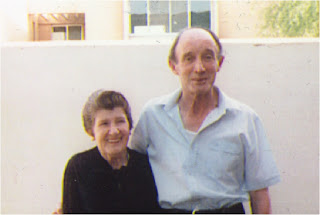


Example using acrylic paints and mediums
Here is an example of starting with a print and painting over the top of it. This is an easy way to paint an original picture without needing to draw! (This is an example to go with the article of the same name below.)
I don't paint a lot of portraits (human ones). I paint a lot of pet portraits and I must say I find painting fur a lot easier than skin. :-) Anyway I thought this would make a good example.
This is a photo of my parents. I don't have many photos of them together in their later years. This particular photo was taken on a holiday to Saudi Arabia. It's a fairly typical holiday ‘snap’.
There are a couple of things that are unfortunate. The top of the wall being in line with Dad’s head is the aspect that I think needs most attention. Also Mum never wore all black outfits; she wore it on this occasion due to the customs of the country they were visiting.
What I did
I printed out the photo on 190g/m² photographic paper; this is a thick quality paper. My printer uses pigmented inks that, once dry, don't run if they get wet.
Even though I made the print 9 by 7 inches (about 22 by 17 cm) I found it was quite small when painting some of the detail. So the picture needed to be done in a loosely painted style.
The Background
Titanium White is an opaque colour so I used a lot of it in the mix to paint the background and to get rid of the rear wall. I used the paints with the minimum of water so the paper wouldn’t buckle too much.
Keep a Copy of the Print for Reference
Once the background was dry I painted in my folks. I used the print to know where to paint the darker and lighter tones.
Changing the Black
It took several layers of paint to change Mum’s outfit to a colour that she would normally wear.
Dad’s shirt was over-painted with a thin wash of colour and a little bit of shading.
I feel I got a reasonable likeness and I know that they would be happy that I made them look a little younger than the photo. ;-)
This technique can be used with any subject; it doesn't have to be a portrait. It would work really well with landscapes of local scene too.